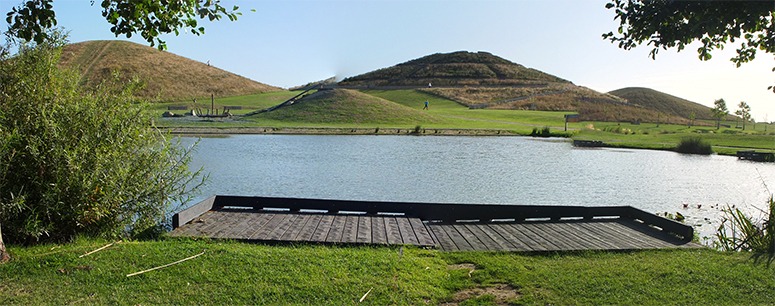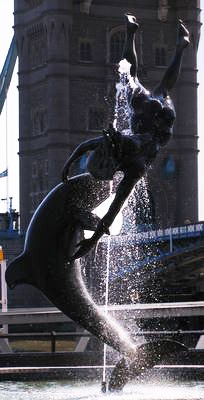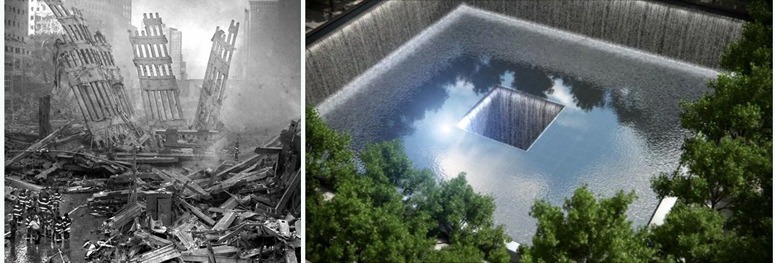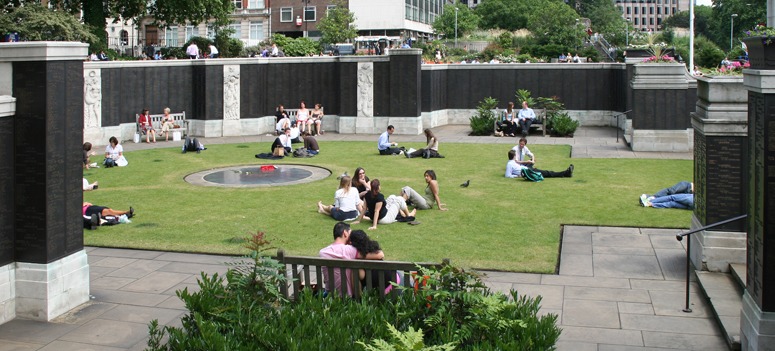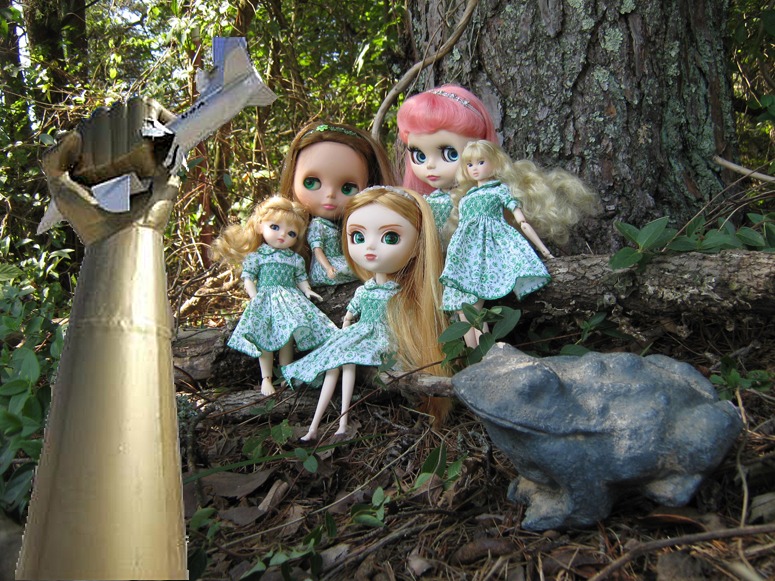Here is the text of the above video reviews of Paul Cummins and Tom Piper’s Blood-swept lands and seas of red, where angels fear to tread.
The poppy installation at the Tower of London is by Paul Cummins, a ceramic artist, with help from Tom Piper, a stage designer. Its name comes from a Derbyshire man who died in Flanders. He wrote of The blood-swept lands and seas of red, where angels fear to tread. There are eight hundred and eight-eight thousand two hundred and forty six poppies: for each British and Colonial death in the First World War.
The Prime Minister, David Cameron, told the House of Commons it was a stunning display, and extremely poignant.
The Washington Post described the installation as ‘a must-see on the tourist trail.
CNN John McCrae’s famous poem, which launched the poppy metaphor: In Flanders fields the poppies blow, Between the crosses, row on row, That mark our place.
The Professor of the History of War at King’s College, observed that : Since the war is still generally misunderstood, such popular interest is encouraging, and the more people who have an opportunity to visit the poppies the better.
The Mayor of London called for the installation to be kept in place a bit longer. A spokesperson from the Historic Royal Palaces responded that The transience of the installation is key to the artistic concept, with the dispersal of the poppies into hundreds of thousands of homes marking the final phase of this evolving installation’.
The actress, Sheila Hancock, suggested that the poppies should be mown down by a tank to commemorate the horror of war.
Jonathan Jones, an art critic with The Guardian, also wanted more horror. He argued that In spite of the mention of blood in its title, this is a deeply aestheticised, prettified and toothless war memorial,
Robert Hardman, for the Daily Mail, responded by calling him a Sneering Left-wing art critic.
So what do I think? Well, as an art installation, it’s hard to fault. As a war memorial, one might think it lacks pathos. But the 1-for-1 symbolism and the fact that the poppies are frozen in time save it from being floral bedding.
For pure pathos a moat-filling tank of red liquid, inspired by Richard Wilson’s installation at the Saatchi Gallery, would have been more telling – and could have evolved into the water-filled moat the Tower needs. But I doubt if this would have raised any money for soldiers’ charities – as the poppies most certainly have done.
Category Archives: public art
6 Replies
Anthony Gormley's Angel of the North and its landscape setting
Gormley is one of my favorite sculptors. I often wish he had taken a course in landscape design but, more often, I wish landscape architects had taken courses in sculpture. The Angel was finished 16 years ago today and the BBC has just played an ‘on this day’ clip of a speech he made at its opening. Gormley explained: ‘I want to convey what it is to be alive at the end of the twentieth century – its immense potential and immense danger’. For me, this encapsulates one of the big things artists should be doing: using images to ‘say’ something about the nature of life.
The above images are from Wikipedia. It has many images which show the sculpture looking good (eg right above) and very few showing it as most people see it from the road (eg left above). From the road is how I normally see it and my usual thought is ‘he should have made it higher’. But with the explanation I heard today I am not so sure. Were it higher, the sculpture would say more about ‘opportunities’ and less about ‘dangers’. Ambiguity is its own message – between the spirituality of an angel and the tragedy of a plane crash or a dying steel industry in the north of England.
The above images are from Wikipedia. It has many images which show the sculpture looking good (eg right above) and very few showing it as most people see it from the road (eg left above). From the road is how I normally see it and my usual thought is ‘he should have made it higher’. But with the explanation I heard today I am not so sure. Were it higher, the sculpture would say more about ‘opportunities’ and less about ‘dangers’. Ambiguity is its own message – between the spirituality of an angel and the tragedy of a plane crash or a dying steel industry in the north of England.
Northala Fields – the landscape planning of a public park
Northala Fields opened as a public park five years ago and I have been slow in making a visit. From the photographs I judged it ‘good but not very good’. After this morning’s visit I have upped this to ‘very good but not excellent’. The landscape planning, however, is excellent:
– the conical hills look good, shield the park from traffic noise, provide destinations for walkers and runners and offer fine views over London. They were made out of rubble from demolishing the old Wembley Stadium. That’s good too – but I wish they had salvaged some features instead of reducing everything to rubble.
– the water park to the south of the hills is an attractive place with ponds, trees, shrubs and wild life
The landscape design was by FoRM Associates, a London practice which was run by Igor Marko, Peter Fink and Rick Rowbotham (the firm operated from 2007-2012). The founders were an artist, an architect and a landscape architect but the latter is not credited with the project: it was regarded as public art.
My visit was a deviation from the route of London’s Capital Ring, which I have been following. It links a number of greenspaces of varying quality. I suppose I could set up a system to assess their quality and, if doing so, would remember the four lunches I have enjoyed in a four day trip. Each time I asked for a ‘bacon roll and cappucino’. Much the best was in a cafe near Eltham College – maybe the boys have trained them. The cost was £3.70. Next best was from a caravan in Richmond Park: £5.20 – good coffee and a very well cooked bacon roll for £5.20. Next best was from a cafe outside Harrow School: £7.20 for a decent coffee with a disappointing bacon sandwich. Worst quality was from a transport cafe beside Streatham Common: £2.70 for flabby white bread and tough bacon. ‘This is not coffee’ I complained after the first sip ‘Yeah – we don’t do coffee’ they told me. The compensation was free newspapers to read (Sun and Star only). Price is the easiest thing to assess but does not correlate with gastronomic quality (for which my assessment criteria were: quality of coffee, quality of bread and quality of bacon. Price does however correlate exactly with quality of service. The most expensive provider also had the best interior design, though it was very traditional. The seating area around the caravan in Richmond Park was a total disgrace ‘wood effect picnic seating made of solid plastic’. So is it true that ‘you get what you pay for’? No: if you want a coffee and bacon sandwich the best buy cost £3.70. The same is true of public open space: the largest budget does NOT produce the best design. Much better to deploy imagination, ingenuity and wisdom.
– the conical hills look good, shield the park from traffic noise, provide destinations for walkers and runners and offer fine views over London. They were made out of rubble from demolishing the old Wembley Stadium. That’s good too – but I wish they had salvaged some features instead of reducing everything to rubble.
– the water park to the south of the hills is an attractive place with ponds, trees, shrubs and wild life
The landscape design was by FoRM Associates, a London practice which was run by Igor Marko, Peter Fink and Rick Rowbotham (the firm operated from 2007-2012). The founders were an artist, an architect and a landscape architect but the latter is not credited with the project: it was regarded as public art.
My visit was a deviation from the route of London’s Capital Ring, which I have been following. It links a number of greenspaces of varying quality. I suppose I could set up a system to assess their quality and, if doing so, would remember the four lunches I have enjoyed in a four day trip. Each time I asked for a ‘bacon roll and cappucino’. Much the best was in a cafe near Eltham College – maybe the boys have trained them. The cost was £3.70. Next best was from a caravan in Richmond Park: £5.20 – good coffee and a very well cooked bacon roll for £5.20. Next best was from a cafe outside Harrow School: £7.20 for a decent coffee with a disappointing bacon sandwich. Worst quality was from a transport cafe beside Streatham Common: £2.70 for flabby white bread and tough bacon. ‘This is not coffee’ I complained after the first sip ‘Yeah – we don’t do coffee’ they told me. The compensation was free newspapers to read (Sun and Star only). Price is the easiest thing to assess but does not correlate with gastronomic quality (for which my assessment criteria were: quality of coffee, quality of bread and quality of bacon. Price does however correlate exactly with quality of service. The most expensive provider also had the best interior design, though it was very traditional. The seating area around the caravan in Richmond Park was a total disgrace ‘wood effect picnic seating made of solid plastic’. So is it true that ‘you get what you pay for’? No: if you want a coffee and bacon sandwich the best buy cost £3.70. The same is true of public open space: the largest budget does NOT produce the best design. Much better to deploy imagination, ingenuity and wisdom.
Patronage – and the lovliest dolphin and naked boy fountain in the world
I once worked in the garden of the David Wynne, who made this fountain – and am glad that his client was not the Caliph El Madhi
What a beautiful fountain, with the silver dolphin and the naked boy!.
A Greek of Constantinople made it, who came travelling hither in the days of my father, the Caliph El Madhi (may earth be gentle to his body and Paradise refreshing to his soul!). He showed this fountain to my father, who was exceptionally pleased, and asked the Greek if he could make more as fine. “A hundred,” replied the delighted infidel. Whereupon my father cried, “Impale the pig.” Which having been done, this fountain remains the loveliest in the world.The fountain delighted David Wynne’s clients and, I guess, it pleases most visitors to Tower Bridge in London. My advice to those who commission public art is: beware of abstract art. They should think in terms of cultural strata. However much the the organizer of a disco may adore Karlheinz Stockhausen, it would not be a popular choice for the playlist.
9/11 Memorial Landscape Architecture
The 9/11 Memorial to the victims of the World Trade Center attack opens today, 11th September 2011. The memorial was conceived by the 42-year-old Israeli-born architect Michael Arad, with help from co-architect, Gary Handel, and landscape architect Peter Walker. The first pool opens on the 10th anniversary of the attack. When completed, it will be a tree-covered plaza with two giant pools marking the footprints of the Twin Towers. Maya Lin, who designed the Vietnam Veterans Memorial in Washington, was on the jury which chose the design. It is difficult to find similarities between the 9/11 attack and Vietnam events but there are undoubted similarities between the memorials. Both are sunken spaces, unlike most traditional memorials. Londoners may compare them to the Merchant Seaman’s Memorial on Tower Hill below), designed by Edward Maufe, which is also sunken and has names carved on black granite. Which of the three groups of people is best memorialised by a sunk space? The Vietnam memorial was criticised for making the fallen soldiers anti-heroes, associated with an unjust war. This cannot be the intention for the 9/11 Memorial.
Since the minimalist squares of the 9/11 memorial are Platonic Forms, they seem closer to God than to Man. Plato’s forms were the universal perfect shapes which must exist before any particular forms can exist on earth. Does their use in a sunk space indicate that the victims of the 9/11 atrocity are destined for a perfect world? Or are they symbols that Death, Revenge and Destruction may also be Platonic Forms which shape the world? If the squares were simply the outlines of the Twin Towers they could be historical traces, like the outline of the old fortress on the Place de la Bastille in Paris. Repetition of the square motif with the pools makes them Platonic forms in my eyes.
Judging only from the photographs, I think the 9/11 Memorial is very beautiful and very moving. Its sustainability credentials are also admirable. But should it be a memorial to human folly, not to the essential eternal wonder of the creation. The pile of rubble on the right-hand photograph would have been a good aid to remembering the tragedy. If it was too dangerous and too big then it could have been 3D-scanned and cast it in steel salvaged from the ruins, at a reduced scale.
There are always other ways of looking at memorials. The 9/11 attack was a disaster from every point of view, injuring both the cause of the attackers and the cause of the attacked. My view is that the Americans should have behaved like a Christian nation and, with the greatest heroism, turned the other cheek. This would have made an immense contribution to the Christian virtues of purity, forbearance, ethical conduct and the rule of law. So I recommend the following interpretation of the 9/11 Memorial: it is a symbol of the lofty idealism for which everyone admires America at its best. It tells us how the nation should have responded to the 9/11 attack. A peaceful response might have dealt a crushing blow to terrorism everywhere, showing that sacrifice purifies the victim and vilifies the perpetrators. This would remind us that the War on Terror was a misconceived and badly executed blunder. So the deep truth in the 9/11 Memorial would be ‘Forgive us, O Lord, for we knew not what were about to do’.
Since the minimalist squares of the 9/11 memorial are Platonic Forms, they seem closer to God than to Man. Plato’s forms were the universal perfect shapes which must exist before any particular forms can exist on earth. Does their use in a sunk space indicate that the victims of the 9/11 atrocity are destined for a perfect world? Or are they symbols that Death, Revenge and Destruction may also be Platonic Forms which shape the world? If the squares were simply the outlines of the Twin Towers they could be historical traces, like the outline of the old fortress on the Place de la Bastille in Paris. Repetition of the square motif with the pools makes them Platonic forms in my eyes.
Judging only from the photographs, I think the 9/11 Memorial is very beautiful and very moving. Its sustainability credentials are also admirable. But should it be a memorial to human folly, not to the essential eternal wonder of the creation. The pile of rubble on the right-hand photograph would have been a good aid to remembering the tragedy. If it was too dangerous and too big then it could have been 3D-scanned and cast it in steel salvaged from the ruins, at a reduced scale.
There are always other ways of looking at memorials. The 9/11 attack was a disaster from every point of view, injuring both the cause of the attackers and the cause of the attacked. My view is that the Americans should have behaved like a Christian nation and, with the greatest heroism, turned the other cheek. This would have made an immense contribution to the Christian virtues of purity, forbearance, ethical conduct and the rule of law. So I recommend the following interpretation of the 9/11 Memorial: it is a symbol of the lofty idealism for which everyone admires America at its best. It tells us how the nation should have responded to the 9/11 attack. A peaceful response might have dealt a crushing blow to terrorism everywhere, showing that sacrifice purifies the victim and vilifies the perpetrators. This would remind us that the War on Terror was a misconceived and badly executed blunder. So the deep truth in the 9/11 Memorial would be ‘Forgive us, O Lord, for we knew not what were about to do’.
What should be done with the Gadaffi Golden Fist Crushing American Jet Statue from his Tripoli compound?
Delighted to see the approaching end of the Gadaffi regime, and having offered an urban landscape idea yesterday, I am wondering how garden designers could help today. One idea is to invite suggestions for what to do with Gadaffi’s respond Golden Fist Crushing American Jet Statue (the Bab al-Azizyah Tripoli compound, where it stands, was stormed a few hous ago). The thinking behind my suggestion is (1) it was a pity that so many statues of Marx and Lenin were destroyed when the Soviet Union fell (2) I like the way London handled a similar problem, by putting a statue of Charles I at one end of Whitehall and a statue of the man who secured the removal of his head (Oliver Cromwell) at the other end of Whitehall (3) history’s monsters should be reviled but not forgotten.
So my suggestion is to place Gadaffi’s Golden Fist American Jet Statue in a garden, to show it is harmless, and to treat it as a rejected toy viewed by frightened children. They would be adult-size plastic scultpures, to symbolise the fact that dictators are plastic-ey overgrown kids. Other ideas welcome.
So my suggestion is to place Gadaffi’s Golden Fist American Jet Statue in a garden, to show it is harmless, and to treat it as a rejected toy viewed by frightened children. They would be adult-size plastic scultpures, to symbolise the fact that dictators are plastic-ey overgrown kids. Other ideas welcome.
Garden image courtesy susan402


